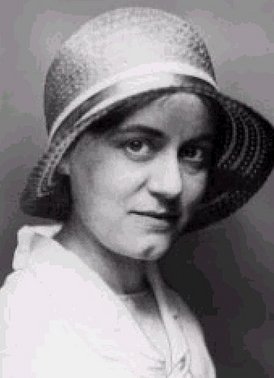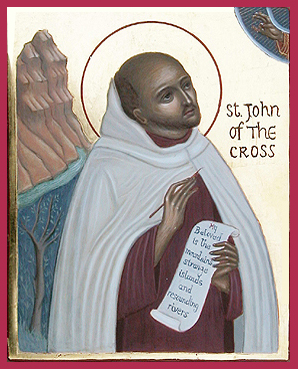The liturgical prayer and some links for Saint Teresa Benedict is here…and a good biography is noted here.
Category: Carmelite saints & blesseds
Saint Teresa of Jesus of the Andes
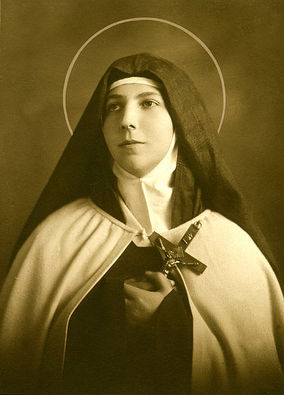 On the liturgical ordo of the Carmelite Order today is the feast of the relatively unknown saint outside some circles (on the Roman ordo today’s saint is memorialized on April 12). Saint Teresa of Jesus of the Andes was born on July 13, 1900 and died on April 12, 1920 and having spent only 11 months as a Carmelite nun.
On the liturgical ordo of the Carmelite Order today is the feast of the relatively unknown saint outside some circles (on the Roman ordo today’s saint is memorialized on April 12). Saint Teresa of Jesus of the Andes was born on July 13, 1900 and died on April 12, 1920 and having spent only 11 months as a Carmelite nun.
Prayer to the Trinity by Blessed Elizabeth of the Trinity
 O my God, Trinity whom I adore; help me to forget myself entirely that I may be established in You as still and as peaceful as if my soul were already in eternity. May nothing trouble my peace or make me leave You, O my Unchanging One, but may each minute carry me further into the depths of Your mystery. Give peace to my soul; make it Your heaven, Your beloved dwelling and Your resting place. May I never leave You there alone but be wholly present, my faith wholly vigilant, wholly adoring, and wholly surrendered to Your creative Action.
O my God, Trinity whom I adore; help me to forget myself entirely that I may be established in You as still and as peaceful as if my soul were already in eternity. May nothing trouble my peace or make me leave You, O my Unchanging One, but may each minute carry me further into the depths of Your mystery. Give peace to my soul; make it Your heaven, Your beloved dwelling and Your resting place. May I never leave You there alone but be wholly present, my faith wholly vigilant, wholly adoring, and wholly surrendered to Your creative Action.
O my beloved Christ, crucified by love, I wish to be a bride for Your Heart; I wish to cover You with glory; I wish to love You…even unto death! But I feel my weakness, and I ask You to “clothe me with Yourself,” to identify my soul with all the movements of Your Soul, to overwhelm me, to possess me, to substitute yourself for me that my life may be but a radiance of Your Life. Come into me as Adorer, as Restorer, as Savior.
O Eternal Word, Word of my God, I want to spend my life in listening to You, to become wholly teachable that I may learn all from You. Then, through all nights, all voids, all helplessness, I want to gaze on You always and remain in Your great light. O my beloved Star, so fascinate me that I may not withdraw from Your radiance.
O consuming Fire, Spirit of Love, “come upon me,” and create in my soul a kind of incarnation of the Word: that I may be another humanity for Him in which He can renew His whole Mystery. And You, O Father, bend lovingly over Your poor little crature; “cover her with Your shadow,” seeing in her only the “Beloved in whom You are well pleased.”
O my Three, my All, my Beatitude, infinite Solitude, Immensity in which I lose myself, I surrender myself to You as Your prey. Bury Yourself in me that I may bury myself in You until I depart to contemplate in Your light the abyss of Your greatness.
(Blessed Elizabeth of the Trinity, 21 November 1904)
Saint John of the Cross
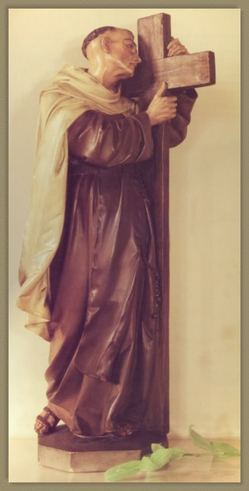 Father, You endowed John of the Cross with a spirit of
Father, You endowed John of the Cross with a spirit of
self-denial and a love of the cross. By following his example, may we come to
the eternal vision of Your glory.
The fundamental principle of
St. John’s theology is that God is All and the creature is nothing. Therefore,
in order to arrive at perfect union with God, in which sanctity consists, it is
necessary to undergo an intense and profound purification of all the faculties
and powers of soul and body. The Ascent–Dark Night traces
the entire process of purgation, from the active purification of the external
senses to the passive purification of the highest faculties; The Living
Flame and The Spiritual Canticle describe the perfection of the
spiritual life in the transforming union. The entire path to union is
“night” because the soul travels by faith. St. John of the Cross
presents his teaching in a systematic manner, with the result that it is
spiritual theology in the best sense of the word; not because it is systematic,
but because it uses as its sources Sacred Scripture, theology and personal
experience.
Catholic Tradition, 1985)
Saint Teresa of Jesus (Avila)
Come, Spouse of Christ, receive the crown which the Lord has
prepared for you for all eternity.
Graciously hear us, O God our Savior, that
as we rejoice in the festival of blessed Teresa, Your Virgin, so may we be fed
by her heavenly teaching and be strengthened in the love of true piety.
This is image of Saint Teresa was done by Bernini and it brings together notable themes of his life and work. Namely, the meeting of heaven and earth; God bowing down to touch the heart of man and woman. Bernini’s influence on doing this sculpture was this passage from Saint Teresa’s autobiography:
“I saw
in his hand a long spear of gold, and at the iron’s point there seemed to be a
little fire. He appeared to me to be thrusting it at times into my heart, and
to pierce my very entrails; when he drew it out, he seemed to draw them out
also, and to leave me all on fire with a great love of God. The pain was so
great, that it made me moan; and yet so surpassing was the sweetness of this
excessive pain, that I could not wish to be rid of it. The soul is satisfied
now with nothing less than God. The pain is not bodily, but spiritual; though
the body has its share in it. It is a caressing of love so sweet which now
takes place between the soul and God, that I pray God of His goodness to make
him experience it who may think that I am lying.” (The Life of Teresa of Jesus, Chapter 29, part 13)
Recall that this saint’s life spanned from 1515-1582 and she was a contemporary with Saint John of the Cross, Saint Ignatius of Loyola and Saint Peter of Alcantara (who encouraged the Carmelite reform) was a spiritual father to her. She is also 1 of 3 women Doctors of the Church. If what you read here appetizing to read more of Saint Teresa’s life and work, I would recommend starting with the brief bio at New Advent, the Interior Castle and then or The Collected Works of St. Teresa of Avila.
Saint Teresa Benedicta of the Cross (Edith Stein)
God our Father, You give us joy each year in honoring the memory of Saint Teresa Benedicta of the Cross. May her prayers be a source of help for us, and may her example of courage and chastity be our inspiration.
Saint John of the Cross
Father, You endowed John of the Cross with a spirit of self-denial and a love of the cross. By following his example, may we come to the eternal vision of Your glory.
THE best exposition on the spiritual life –that is, in my estimation there is no other work that captures the essence of the various gifts of the Holy Spirit with regard to the spiritual life– is the book Christian Spirituality by Dominican Father Jordan Aumann (1916-2007). Regrettably, I think the book is out of print and old copies tend to be expensive but you may search for an online copy of it. If you get a copy, don’t let it out of your sight! Nevertheless, Father Jordan’s thoughts on Saint John of the Cross easily expose the greatness of today’s saint.
Saint Teresa of Avila sets all our hearts on fire
Oh Beauty exceeding
 All other beauties!
All other beauties!
Paining, but You wound not
Free of pain You destroy
The love of creatures.
Oh, knot that binds
Two so different,
Why do You become unbound
For when held fast You strengthen
Making injuries seem good.
Bind the one without being
With being unending;
Finish, without finishing,
Love, without having to love,
Magnify our nothingness.
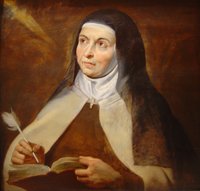 The Interior Castle is the principal source of mature Teresian thought on the spiritual life in its integrity. Chief emphasis is laid on the life of prayer, but other elements (the apostolate, for example) are also treated. The interior castle is the soul, in the center of which dwells the Trinity. Growth in prayer enables the individual to enter into deeper intimacy with God–signified by a progressive journey through the apartments (or mansions) of the castle from the outermost to the luminous center. When a man has attained union with God in the degree permitted to him in this world, he is “at the center” of himself; in other words, he has integrity as a child of God and as a human being. Each of the apartments of the castle is distinguished by a different stage in the evolution of prayer, with its consequent effects upon every other phase of the life of the individual. (from an essay by a Carmelite nun, Austria)
The Interior Castle is the principal source of mature Teresian thought on the spiritual life in its integrity. Chief emphasis is laid on the life of prayer, but other elements (the apostolate, for example) are also treated. The interior castle is the soul, in the center of which dwells the Trinity. Growth in prayer enables the individual to enter into deeper intimacy with God–signified by a progressive journey through the apartments (or mansions) of the castle from the outermost to the luminous center. When a man has attained union with God in the degree permitted to him in this world, he is “at the center” of himself; in other words, he has integrity as a child of God and as a human being. Each of the apartments of the castle is distinguished by a different stage in the evolution of prayer, with its consequent effects upon every other phase of the life of the individual. (from an essay by a Carmelite nun, Austria)
Graciously hear us, O God, our Savior, that as we rejoice in the festival of blessed Teresa, Thy Virgin, so may we be fed by her heavenly teaching and be strengthened in the love of true piety.
Saint Thérèse of Lisieux, the Little Flower and Doctor of the Church
From the First Steps on the Little Way of St. Thérèse of Lisieux
God has raised up St. Thérèse of Lisieux, Doctor of the Church, to enable us to grasp and live the profound truth of divine Love with the same intensity as she lived it. Or to put it another way, the Church has proclaimed St. Thérèse a Doctor of the Church in order to help God’s people love the love that is mercy.
Therese was so convinced about how much we need to love the love that is mercy – instead of some twisted, inept infatuation with justice – that she made it the theme of a little Christmas play she wrote and performed for the community in 1894.
In the play, the Angel of Judgment approaches the infant Jesus in the manger and says this:
Have you forgotten, Jesus, O Beauty supreme, that the sinner must at last be punished? I will chastise the crime in judgment; I want to exterminate all the ungrateful. My sword is ready! Jesus, sweet victim! My sword is ready!! I am set to avenge you!!! (Theatre au Carmel, Paris: Cerf DDB, 1985, p. 108, author’s translation)
And the baby Jesus replies:
O beautiful angel! Put down your sword. It is not for you to judge the nature that I raise up and that I wish to redeem. The one who will judge the world is myself, the one named Jesus! The life-giving dew of my Blood will purify all my chosen ones. Don’t you know that faithful souls always give me consolation in the face of the blasphemies of the unfaithful by a simple look of love? (ibid.)
This little dramatic scene proved to be prophetic. In it we see prefigured the very model for Thérèse to be proclaimed a Doctor of the Church. We hear a little child… speaking with the authoritative voice of God…correcting a destructive concept of divine justice…offering a new way to grasp God’s love…and transforming the world through a graced teaching on God’s mercy.
